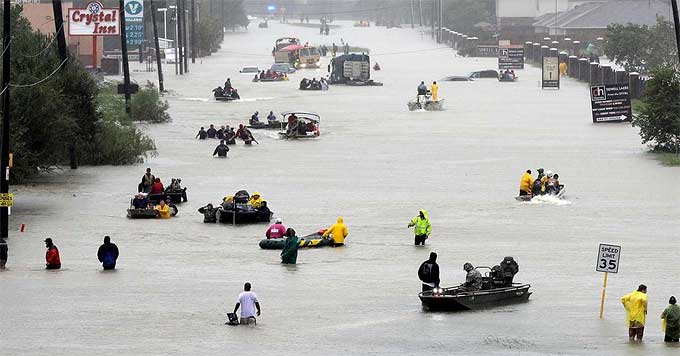Ideal Bug Out Boat For Preparedness
Guest post by “Bogan”
Boat To Safety.
The images of the flooding in Houston in the wake of Hurricane Harvey are everywhere in the media these days. They are filled with pictures of boats of one kind or another which are being deployed to get the living to safety, among other tasks.
The Cajun Navy and other flotillas are out in force and Bass Pro, among others, has donated boats to the cause. Every imaginable kind of boat seems to be out there ranging from small kayaks to bass boats to air boats to ski boats, speed boats and party barges (pontoon boats) and more. All are doing good work.
And why not? After all, boats have a storied history (starting with Noah!) of getting people to safety.
With the Hurricane Harvey flooding experience etched into people’s minds if you were to ask a Gulf Coast resident today “if you knew a worst case scenario was coming to your neighborhood what kind of boat would you have to get you (and who and what are important to you), to safety?”, I expect you would get a variety of opinions.
The question is not a purely academic one; rather it invites a practical assessment.
Even though I don’t live in Houston, I have family and business associates that live there, so have special interest when looking at the scenario presented. So how would I answer that question?
Looking at it from afar, for a small family in Houston or anywhere near the Gulf Coast for that matter, I suspect an ideal craft would be something like a wide beamed johnboat with a sturdy hull, with some sort of jet-drive motor or “mud” motor.
The reason for the flat bottom and the motor type is to enable the boat to run in shallow water. The sturdy hull is to maintain integrity with hidden objects and stay afloat.
The motor types (actually there are several variants of “mud motors”) are designed to run with impunity in shallow water.
This type of boat would designed to allow a small family a good chance at escape to safety in a flooding scenario, even if it meant launching from your driveway in the face of rising water.
(Keeping with practicalities: If you boat, fish or hunt in the good times, a boat like this would see a lot of use in that region, so it would not be an expensive lawn ornament gathering dust waiting for the thousand year flood or other Armageddon event.)
The same question could also be asked of any of the readers of this blog in their unique situations, wherever located.
For example, my worst case scenario doesn’t involve flooding, as our home is on a hill, but rather a need to reposition my family from the outskirts of a major eastern metropolis to a designated location some 50 miles away. If the need to move arises, I estimate the roads will be clogged or otherwise dangerous. A boat is an option — my starting point and destination are in the same drainage.
(If you are located inland, since rivers are the “road” for a boat, one can easily find maps of drainages to see what their own route to safety might be.)
The path I need to follow is to wrestle a boat approximately one mile (mostly downhill) where I can put it into a sizeable feeder stream, and from there navigate it to a river and then to a large lake.
My designated location is at the far end of the lake, and a mile or so back in the woods.
I have picked a light and narrow 14’ semi-vee aluminum boat with a fairly flat bottom near the stern, which drafts very little water (i.e. it floats high).
Light because it has to be carried – and at 115 lbs, a thirty something or two fifty somethings can carry it.
Semi-vee because the hull type handles large water better than a flatbottom, and narrow prow helps to thread through narrow spots, and past “sweepers” in the river.
It will hold three people, plus emergency gear, plus a small but strong outboard (15hp) that can scoot us quickly to safety once the water depth permits.
Finding a suitable aluminum boat used is not an expensive proposition – sometimes they are available for free. I picked up mine on craigslist for $100 a few years ago – the amount is not unusual for a used boat, although new it would be around $1,800.
Some tweaks I have made to it are to fortify the carry handles, paint it camo inside and out to reduce its visibility, coat the bottom with a special paint to withstand rock damage, and install an extra set of oarlocks so two sets of oars can row at once (EMP proof!).
Everybody’s scenario is different, though. For some, open water like the great lakes or the ocean might be a factor, for others a boat might be just one of several options on a multi-platform contingency plan (motor home, boat, motorcycle, bicycle).
Any scenario drives different boat choices, and the possibilities are wide ranging.
What is your worst case scenario, and is a boat one of your solutions? What is the reasoning behind your choices?
-Bogan

